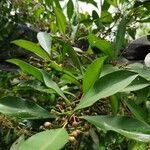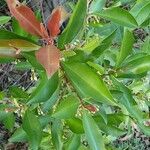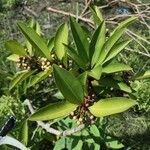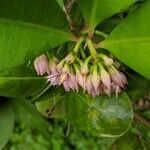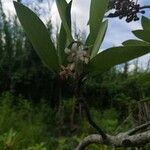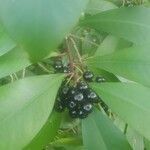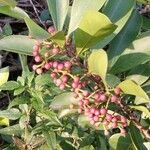Shrub or small tree to 4 m high; branchlets somewhat angular. Leaves spirally arranged; petiole (2–) 5–12 (–15) cm long; lamina usually oblanceolate to elliptic-lanceolate, (5–) 8–13.2 cm long, (1.4–) 3–4.6 cm wide, chartaceous, margin smooth, glands globular to lineate pellucid, drying to red. Inflorescence terminal or subterminal, umbellate to subumbellate, 4–5 cm long, 6–11 flowers per inflorescence; peduncle 2–3.5 cm long; pedicels 8–17 mm long, often curved. Flowers 5-merous, to 10 mm long; calyx tube 0.5–1 mm long, lobes rounded, 1.5–3 mm long, 1.5–2 mm wide, ciliolate; corolla rotate, pale pink, tube c. 1 mm long, lobes 7–9 mm long, 3–4 mm wide; stamens may alternate with 1–5 pink petaloid staminodes; filaments c. 2 mm long, fused at base, anthers cohere around exserted style, 4–5 mm long, septate, opening by introrse longitudinal slits; ovary globular, c. 1 mm diam.; ovules multiseriate, 17–20. Fruit depressed-globular, 5–7 mm high, 6–8 mm wide, whitish to pinks, reds and purples, maturing purplish black to black. Seed c. 5 mm diam.
Shrubs, not stoloniferous , 1-2 m; branchlets conspicuously black punctate-lineate, glabrous. Leaves: petiole 5-10 mm, glabrous; blade oblanceolate or obovate, 6-12(-16) × 3-5(-7) cm, margins entire, revolute, (without vascularized nodules), apex obtuse or acute, surfaces glabrous. Inflorescences lateral or subterminal, on basally thickened lateral branches, subumbels or umbels, 5+-flowered. Pedicels erect, ca. 1-2 cm, glabrous. Flowers: sepals 5, broadly ovate, ca. 1 mm, margins subentire, (minutely ciliate), apex rounded, densely black-punctate, glabrous; petals 5, pink or white, broadly ovate, 6-8 mm, margins entire, (hyaline, scarious), apex long-acuminate, densely punctate, glabrous; stamens subequaling petals; anthers linear-lanceolate, transversely septate-lobed, apex apiculate, punctate abaxially; ovary pellucid-punctate, glabrous; ovules 5+, multiseriate. Drupes red or purplish black, subglobose, ca. 8 mm diam., minutely punctate. 2n = 48.
A shrub. It grows 5 m tall. The leaves are alternate and leathery. They are narrowly oval. The flower groups are in the axils of leaves. The flowers are light pink. The fruit turn red as they ripen, then deep purple to black. The fruit are 8 mm across. The seeds are round and 5 mm across.
